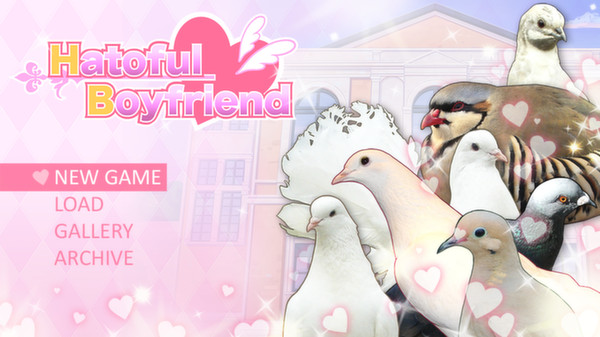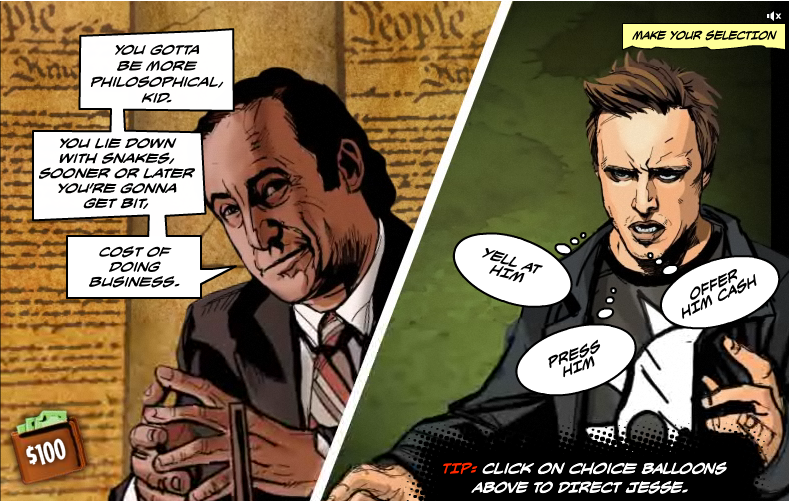Visual Novels: More than Meets the Eye
An introduction to visual novels about: their content, context and how they are made.

Some of you, if not most, may have heard about visual novels. They might only seem weird and quirky Japanese stories, for instance about high school pigeon dating, but there is a lot more to the visual novel format and its potential to tell engaging stories.
What is a Visual Novel?

“Hatoful Boyfriend”
Visual novels are a format for interactive storytelling that started in Asia and is slowly making its way into the Western market. The story is accentuated by visuals, for instance: the characters have a limited set of poses and expressions that are used to convey their emotions, and interactive choices allow the reader (or player) to influence the story. It’s a minimalistic, but powerful format to tell an infinite amount of stories with.
“The Cost Of Doing Business, A Jessi Pinkman Game”
There is a format called ‘motion comic’ in the West, which also uses visuals and player choice to tell stories. However, this format has detailed visuals, whereas a visual novel puts more emphasis on the text.
Demand for Visual Novels in the West
These novels have been increasing in popularity in the West over recent years. As a result, more and more existing novels are getting officially translated and some are even specifically developed for the Western market. They now have their own category on Steam and are frequently funded on Kickstarter.
With the interest for visual novels picking up, it’s not surprising that Asian publishers have chosen to start including the Western market, because they already have proof there is profit to be made. This does raise the question: why did visual novels fail to be released officially in the Western market sooner? According to Tyler Ohlew (2014):
“It’s difficult to pinpoint the exact reasons […] but considering how fickle Japanese publishers were in regards to what was brought over to the West, it's possible the blame falls on their own hesitance.”
In Japan around 70% of all released PC games are visual novels. While they have not approached this level of popularity in the West, their arrival in the Western market is surely a good sign for this format.
Complexity of the Visual Novel Format
They may seem very simple, but executing them well is not a simple task:
“A visual novel lives and dies by its story and characters (...).” Phoenix Spaulding (2014).
In terms of art and design, this medium is created with limited resources. Sometimes, this is an aesthetic choice, but it can also be financial. According to Lindsay Woods (2015):
“You distil your characters into a set of poses and expressions that are going to repeatedly represent them as they go through your story, and you carefully choose what events warrant new artwork.”
In conclusion, visual novels are a complex, and minimalistic, form of storytelling that requires more know-how than might seem to be the case.
Examples of Visual Novels on Steam

Orion
“A science-fiction visual novel centered on the implications of time travel, artificial intelligence, and humanity’s ascent to the stars.” – Official Steam description

Solstice
“Solstice is a dystopian mystery thriller about small personal disasters that turn into great catastrophes.” – Official Steam description

Who is Mike
“You wake up with an aching head and the world out of focus. In front of you is a man accusing you of being “fake”. He looks exactly like you, down to the last scar and pimple, has the same memories, the same voice and the same personality. But who is lying and who is telling the truth?” – Official Steam description
Content of Novels
'Hatoful Boyfriend', a pigeon dating sim that was mentioned earlier, might not seem like it would be very popular, but it’s actually doing really well in the West and has inspired a lot of other strange dating simulator novels to be made.

“Hatoful Boyfriend: Holiday Star”
A downside to this is that this generates the impression that all visual novels are this silly. This scope, of what a novel can be about, is actually a lot wider: their content can vary from being very superficial, to having a lot more depth. It all depends on the story that was written.
For instance, visual novels can take 20 minutes, 48 hours, or even far longer to play through. When the replay value is added to this, that number increases substantially. This is important to consider because visual novels are meant to be played through more than once to experience all the storylines. For these reasons, visual novels are relatively cost effective to make in relation to their replay value.
Difference between markets
Some steps are needed for visual novels to succeed in the Western market.
For instance, some novels completely lack an introduction tutorial, which makes them difficult to initially experience by people who are new to this medium.
In terms of content or visual style they might not always align with the demand of Western market, although there is possibility to use other art styles. On top of that, there might be wrong assumptions about the content of visual novels in general.
Not a lot of companies seem to take advantage of this complete scope just yet. There seems to be a hesitance from developers to experiment and innovate. Perhaps this is due to the origins of the format, because in Asia the visual novel is more ingrained in day to day culture, than in the West. For that reason it has to follow stricter guidelines. However, it would seem that these expectations don’t apply as strongly in the West.
Therefore, visual novels could have a much wider potential in the West than in their original market.
In conclusion
Visual novels are a complex format, and we are only scratching the surface of what can be told through them. Steps need to be made to find out what the rules are in the Western market. Only time will tell what diverse and unique stories can and will be told through this medium. I look forward to seeing them grow in the future, both as a developer and as a reader.
Currently, I am researching and playtesting visual novels for my Masters research (game and technology) at NHTV University in Breda. I have a Bachelor in Illustration (AKV|St. Joost, Breda) and have a background in animation. If you have information you would like to contribute or have any questions you can share them in the comments below.
Thank you for your time!
Read more about:
BlogsAbout the Author(s)
You May Also Like













